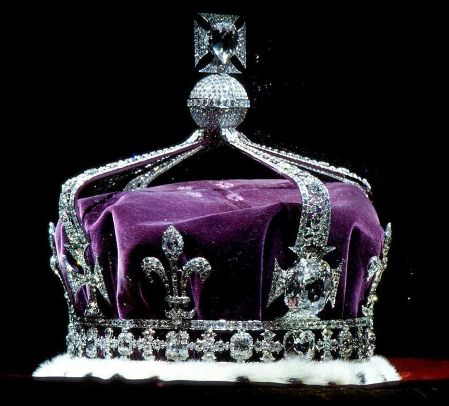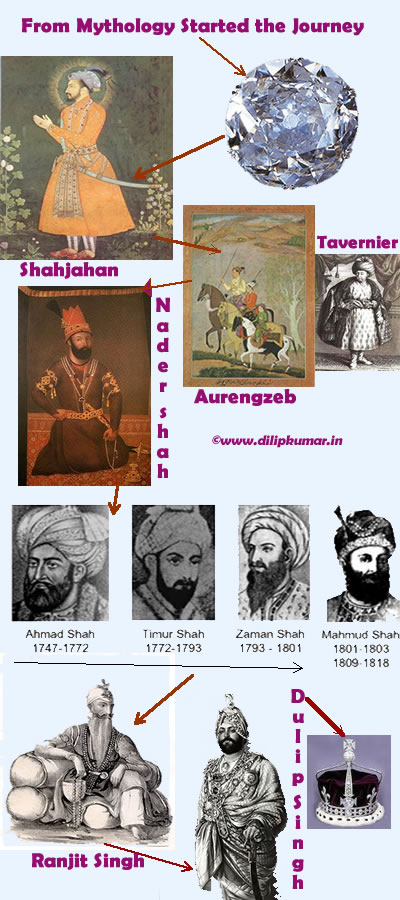The Legend of Koh - I - Nur Diamond - about it's tale, myth and the curse
 |
| The world famous Koh-i-noor diamond accentuates the grandeur of the crown of Britain's Queen Elizabeth, the Queen Mother. The platinum crown includes other precious gems |
The Kōh-i Nūr which means "Mountain of Light" in Persian, also spelled Kohinoor, Koh-e Noor or Koh-i-Nur, is a 105 carat (21.6 g) diamond that was once the largest known diamond in the world.
The Kōh-i Nūr originated at Hyderabad, Guntur district in the state of Andhra Pradesh in India. It has belonged to various Hindu, Mughal, Persian, Afghan, Sikh and British rulers who fought bitterly over it at various points in history and seized it as a spoil of war time and time again.
It was finally seized by the East India Company and became part of the British Crown Jewels when Queen Victoria was proclaimed Empress of India in 1877.
There are many diamonds of majestic sizes in India during that time like "Babar's," "the Mogul's," "Pitt's," "the KOH-I-NUR," etc. There were many theroies saying that all are one. Some said all were different. Many historians put their theories.
Dr. Ball has gone carefully into the question of these diamonds .
It is now likely for sure that there are three diamonds in existence which have a direct bearing upon the questions raised concerning the identity of the Great Mogul and Babur’s diamond.
They are the Orlov weighing 189.62 metric carats, now in the Kremlin; the Darya-I-Nur, with an estimated weight of between 175 and 195 metric carats and presumed to still be among the Iranian Crown Jewels; and the Koh-I-Noor, whose former weight before it was recut was 186 carats, equivalent to 190.3 metric carats.
Dr.Ball pointed out about the Moguls - "Several writers, among them Professor Schrauf of Vienna (1869), have suggested that the Mogul’s diamond is to be identified with the similarly shaped Orloff now belonging to Russia. Apart from the discrepancy in the weights and in the size, as shown by Tavernier’s drawing, which was intended to represent the natural size of the former [the Mogul], it is tolerably certain that the Orloff was obtained from the temple of Srirangam on an island in the Cauvery river in Mysore. It was therefore a possession of the Hindus, and it is most improbably that it ever belonged to the Moguls."
As regards the diamond "as large as a hen's egg," said to have been found at the sack of Vijayanagar and presented to the Adil Shah . Couto (Decade VIII. c. xv.) says that it was a jewel which the Raya had affixed to the base of the plume on his horse's head-dress. Garcia da Orta, who was in India in 1534, says that at Vijayanagar a diamond had been seen as large as a small hen's egg, and he even declares the weights of three others to have been respectively 120, 148, and 250 MANGELIS, equivalent to 150, 175, and 312 1/2 carats .
 |
| A tentative Path way of Kohinoor tracing from Shah Jahan to British Crown |
It is clear that this hen's egg diamond could not be the fame as Sultan Babar's, because the former was taken at Vijayanagar in A.D. 1565, whereas Sultan Babar's was received by his son Humayun at Agra in 1526, and could not have been, forty years later, in the possession of the Hindu king of the south.
Dr. Ball has shown that probably the KOH-I-NUR is identical with the "Mogul's diamond." Was, then, this "hen's egg" diamond the same? Probably not. If we had been told that the "hen's egg," when found in the sack of Vijayanagar, had been cut, the proof CONTRA would be conclusive, since the KOH-I-NUR was certainly uncut in A.D. 1656 or 1657. But there is no information available on this point.
The "hen's egg" was apparently taken by the Adil Shah to Bijapur in 1565, and it is not likely to have found its way, still in an uncut state, into the possession of Mir Jumla in 1656. So it may be that all these diamonds were mined from India and followed various paths of War, Wins, Swords.
The Path of The Gem
Now coming to the story of Koh- I- Noor . According to popular mythological legends koh-i-noor is considered to be the Samantak Mani (diamond) described in the ancient sanskrit texts . There are many myths and legends surrounding this astounding gem. Some theories says it as the Babur's. But as said above there is some certainty that it is different. As per the recorded history from the Chronicle of Fernao Nuniz and Paes, Robert Swell records the path of Kohinoor in his book "The Forgotten Empire"
The principal mines of the Deccan were on the north bank of the Krishna river, and in the Kurnool and Anantapur countries, notably at Vajra Karur. Generically these are known as "the mines of Golkonda," and the phrase has passed into a proverb.
The KOH-I-NUR was found at Kollur on the river Krishna, probably in A.D. 1656. Mir Jumla farmed the mines at that time, and presented it uncut to the emperor, Shah Jahan. It is said to have weighed 756 English carats . It was entrusted to a Venetian named Hortensio Borgio, and was so damaged and wasted in his hands that, when seen by Tavernier in Aurangzib's treasury in 1665, it weighed not more than 268 1/2 English carats.
In 1739 Nadir Shah sacked Delhi and carried the stone away with him to Persia, conferring on it its present immortal name the "Mountain of Light." On his murder in 1747 it passed into the hands of his grandson, Shah Rukh. Four years later Shah Rukh gave it to Ahmad Shah Durani of Kabul, and by him it was bequeathed to his son Taimur.
In 1793 it passed by descent to his son Shah Zaman, who was blinded and deposed by his brother Muhammad; but he retained possession of the stone in his prison, and in 1795 it became the property of his brother Sultan Shuja.
In 1809, after Shuja became king of Kabul, Elphinstone saw the diamond in his bracelet at Peshawur. In 1812, Shuja, being dethroned by Muhammad, fled to Lahore, where he was detained as a quasi-prisoner by Ranjit Singh, the ruler of the Punjab.
In 1813 an agreement was arrived at, and Shuja surrendered the diamond to Ranjit Singh. Ranjit often wore the stone, and it was constantly seen by European visitors to Lahore. Dying in 1839, the KOH-I-NUR was placed in the jewel-chamber till the infant Dhulip Singh was acknowledged as Ranjit's successor. In 1849 it was handed over to Sir John Lawrence on the annexation of the Punjab, and by him was sent to England to Her Majesty the Queen.
The Koh-i-Noor left the shores of India on April 6, 1850, and on reaching London on July 2, 1850, it was handed over to the Board of Directors of the East India Company. Sir J.W. Logg, the Deputy Chairman of the East India Company, presented it to Queen Victoria.
The queen recorded in her journal: “The jewels are truly magnificent. They had also belonged to Ranjit Singh and had been found in the treasury of Lahore…. I am very happy that the British Crown will possess these jewels for I shall certainly make them Crown Jewels”.
In 1851 it was exhibited at the first great Exhibition, and in 1852 it was re-cut by an Amsterdam cutter, Voorsanger, in the employ of Messrs. Garrards. The weight is now 106 1/16 carats.
In 1911 a new crown was made for the coronation of Queen Mary with the KOH-I-NOOR as the center stone. In 1937, it was transferred to the crown of Queen Elizabeth (now Queen Mother) for her coronation. It is now on display with the British Crown Jewels in the Tower of London.
Controversy and Claims
In the 20th century there was further controversy surrounding the Koh-I-Noor, namely the question of its rightful ownership. It wouldn’t be uncharitable to suggest that on the majority of occasions which the subject has been raised on, it has been due to the efforts of politicians anxious to score poll points off one another rather than to any initiative on the part of those who may harbor deep-seated feelings about the gem.
In 1947 the government of India asked for the return of the Koh-I-Noor: at the same time the Congress Ministry of Orissa claimed that the stone actually belonged to the god Jaganath, despite the opinion of Ranjit Singh’s treasurer that it was property of the state. Another request followed in 1953, the year of the coronation of Queen Elizabeth II. But the real fight erupted in 1976 when the Prime Minister of Pakistan, Zulfikar Ali Bhutto, in a letter to the British Prime Minister, James Callaghan, submitted a formal request for the return of the diamond to Pakistan. This was refused but was accompanied by an assurance by Callaghan to Bhutto that there was no question that Britain would have handed it over to any other country.
The view of the British government was reported at the time to have been that the history of the diamond is so confused and that Britain has a clear title, in that the diamond was not seized in war but formally presented — the last statement being a somewhat curious interpretation of the events of the 19th century. Remember, the Koh-I-Noor being handed over was one of the terms of the Treaty of Lahore.
They did not have much choice in the matter. Pakistan’s claim to the Koh-I-Noor was disputed by India, which made another formal request for its restoration. Shortly after, a major newspaper in Teheran stated that the gem ought to be returned to Iran.
The Curse?
It is believed that the Koh-i-Noor carries with it a curse and only when in the possession of a woman will the curse not work. All the men who owned it have either lost their throne or had other misfortunes befall them.
Queen Victoria is the only reigning monarch to have worn the gem. Where the monarch is male, the stone is passed to his spouse. The possibility of a curse pertaining to ownership of the diamond dates back to a Hindu text relating to the first authenticated appearance of the diamond in 1306: "He who owns this diamond will own the world, but will also know all its misfortunes. Only God, or a woman, can wear it with impunity."
So shuttling various hands the diamond is now happily resting in the crown of British Queen and may be continue for coming time, unless the valuable stone decides to play another game...
